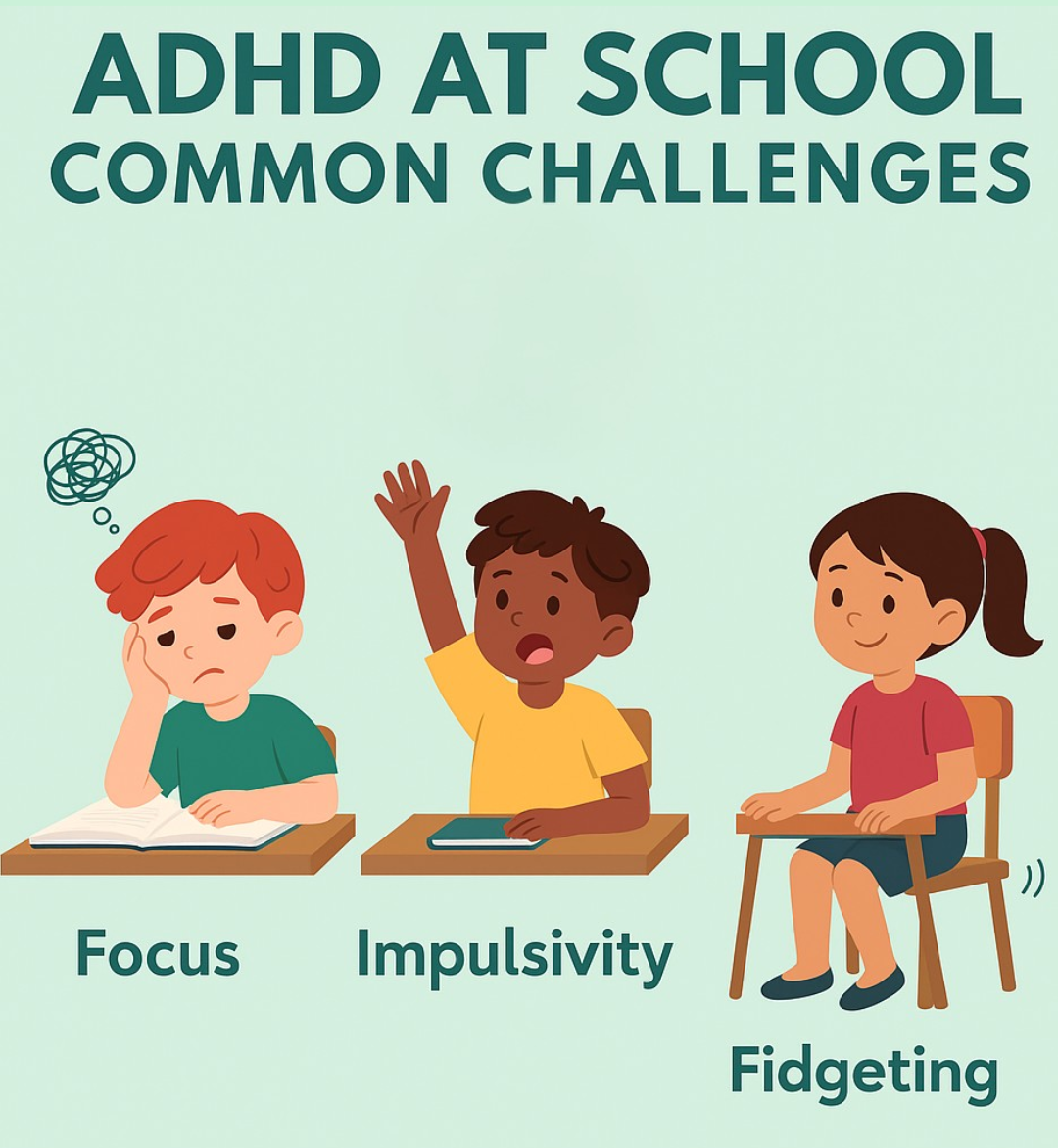
ADHD Parent Guide
A clear, practical guide for families—what ADHD is, how it shows up in children and teens, treatments that help, and how to secure support at school.
Book AppointmentWhat is ADHD?
Attention-Deficit/Hyperactivity Disorder (ADHD) is a developmental condition with persistent patterns of inattention, hyperactivity, and/or impulsivity that begin in childhood and impact daily life at home, school, and with friends.
Key point: ADHD is common and treatable. Many children do well with the right supports.
Symptoms in Children & Adolescents
Inattention
- Careless mistakes; misses details
- Hard to sustain focus
- Doesn’t seem to listen
- Disorganized; loses items
- Easily distracted; forgetful
Hyperactivity / Impulsivity
- Fidgets; “on the go”
- Leaves seat; runs or climbs excessively
- Talks excessively; blurts out answers
- Difficulty waiting turn
- Interrupts or intrudes
Evidence-Based Therapies
Behavior Therapy
- Parent training in behavior management
- Positive reinforcement; consistent routines
- Clear rules; visual schedules
Cognitive-Behavioral Strategies
- Task-breaking; checklists; timers
- Organization & planning skills
- Emotion regulation & coping tools
Under age 6: Parent-training first. Age 6+: Combination of therapy and, when indicated, medication.
Medications
Two main categories help ADHD symptoms. Responses vary by child; dosing is individualized and monitored.
Stimulants
| Type | Examples | Side Effects |
|---|---|---|
| Methylphenidate | Ritalin LA, Concerta | ↓ appetite, insomnia, headache |
| Amphetamine | Adderall XR, Vyvanse | ↓ appetite, irritability, ↑ heart rate |
Non-Stimulants
| Class | Examples | Side Effects |
|---|---|---|
| Norepinephrine reuptake inhibitors | Atomoxetine (Strattera), Viloxazine (Qelbree) | Nausea, fatigue, insomnia; rare mood changes |
| Alpha-2 agonists | Guanfacine ER, Clonidine ER | Drowsiness, dizziness; taper to stop |
Managing Side Effects
- Appetite: give with meals; evening snack
- Sleep: earlier dosing; shorter-acting form; sleep hygiene
- Drowsiness (alpha-agonists): start low, titrate slowly; avoid missed doses
How to Help Your Child Do Better at School & Get Accommodations
When ADHD or other mental-health challenges affect schoolwork, federal laws can provide supports so your child can access a free and appropriate public education.
Two Main School Plans
- IEP (Individuals with Disabilities Education Act) — the most comprehensive option; may include resource-room time, specialized instruction, related services (e.g., counseling), extra time for tests, and more.
- Section 504 Plan (Rehabilitation Act) — keeps the student in the general classroom but adds agreed-upon accommodations (e.g., extended time, preferential seating, reduced distractions, organizational support).
Parent Action Steps
- Talk with the teacher(s). Share observations and ask what’s getting in the way of learning; request classroom strategies.
- Request a school evaluation in writing. A simple letter works: “I am requesting an evaluation for my child.” Keep copies of all correspondence.
- Participate in the team meeting. Review results with the IEP/504 team (teachers, school psychologist, nurse, evaluators). You may invite your child’s clinician(s).
- Build the plan. Agree on accommodations, modifications, and services that match your child’s needs. You (and your child, when appropriate) must approve recommendations; you can appeal decisions.
- Communicate and adjust. Ask teachers to flag when supports aren’t working so you can update the plan together.
- Seek an advocate if needed. Local organizations can help you navigate IEP/504 processes; educational attorneys are another option if services are denied.
Examples of Supports
Classroom
- Preferential seating; reduced distractions
- Visual schedules; chunked assignments
- Check-ins for organization & planning
- Movement breaks; alternative test setting
Testing & Workload
- Extended time; separate location
- Smaller problem sets with equal mastery
- Audio support or read-aloud when appropriate
- Assistive tech (timers, planners, organizers)
Checklist: Getting Accommodations for ADHD
- ☐ List school concerns (attention, organization, work completion, behavior, testing)
- ☐ Collect documents (report cards, teacher emails, prior evals, clinical notes)
- ☐ Send a written evaluation request to the school
- ☐ Attend the IEP/504 meeting; bring your notes and questions
- ☐ Confirm specific accommodations/services in the final plan
- ☐ Set a communication schedule with teachers (e.g., monthly check-ins)
- ☐ Track what works; request plan updates if supports aren’t effective
- ☐ Contact a local advocate if you need help
This section is informational and not legal advice. For personalized guidance, consult your school district and education resources.
Ready to Get Help?
Book an appointment with our compassionate providers today.
Book AppointmentReferences
- National Alliance on Mental Illness (NAMI) — Getting Your Child Mental Health Support and Accommodations in School